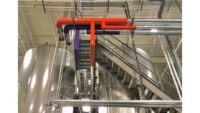Let's all give special thanks to the BuilConn folks for hosting this meeting, and to the CABA organization for giving the newly formed consortium a home.
A Plea for Cooperation
The first paragraph of the open letter reads:"The Building Controls industry has made great strides over the last 10 years in the creation of communications standards. Both BACnet and LonTalk are now viable, commercially accepted solutions that provide owners with open communications. Yet while we have made great progress in these areas as an industry, there has been an emergence of a larger, more globally accepted standard created by the world of Information Technology. In particular, the broad acceptance and ever lowering cost of Ethernet/TCP/IP/XML communications is finding its way into our industry."
Paul Ehrlich, of Trane Global Controls, spearheaded the meeting by achieving agreement by all that XML standards are required and continued with a strong call to action.
An objective was established to work aggressively and complete a first draft of the guideline within nine months. This will require a core group to work upwards of 20% time for the rest of the year. The group would be split into a number of working groups requiring biweekly conference calls. The whole consortium would require quarterly face-to-face meetings. The next meeting will be at Realcomm in Chicago.
The review of the Dallas meeting on the AutomatedBuildings.com website includes a picture and connection to CABA links for XML guidelines, a member list, minutes, and links to the original open letter to the industry (www.automatedbuildings.com/news/may03/reviews/builconn2003.htm).
Starting from the beginning
I contacted Paul prior to writing this column, and the following is a portion of his response:"Presently I am building a list of parties interested in participating in active work on the project. This will require significant investment of time and resources from committee members. Presently we have interest from control companies, equipment manufacturers, owners, and consultants from around the world.
The next step will be to do a conference call with those interested in actively participating this week; at that time, we will propose an agenda and committee structure. (This meeting took place last month, but too late for a report in this issue. Keep an eye on this space for updates.)
As far as my personal/corporate interest in this topic ... Well, we believe that XML and Web services are a clear direction for the future. Owners are seeing (or wanting to see) their buildings as being a source of data, in the same way that they use their sales information, manufacturing information, and financial information for business intelligence. They also are seeing their IT networks as being both the backbone for communications and the channel to collect and disseminate all business data.
Use of industry specific standards (proprietary protocols, BACnet, LonTalk, Modbus, etc.) can work to achieve this, but doing so requires some translation and also has some fairly serious challenges. Examples of these challenges include security (both encryption and authentication), traversing firewalls, compatibility with databases and business applications, and support by IT staff.
Utilizing common network standards in an open, interoperable method will allow for ready integration of subsystems and also integration with business systems in a method that can be secure and extensible. We have already seen this happen in our industry for human-readable data with control systems that are using Web browsers for user interface. Defining standards for XML and Web services will allow the same thing to occur for communications between machines."
Thank you, Paul, and thanks to the Trane Company for Paul's time. Thank you also to all of those other companies yet to be identified that are prepared to put time, money, and resources into this industry-wide project. Please join me in providing your support in anyway that you can to help move our industry forward, providing a seamless connection to the future. ES




